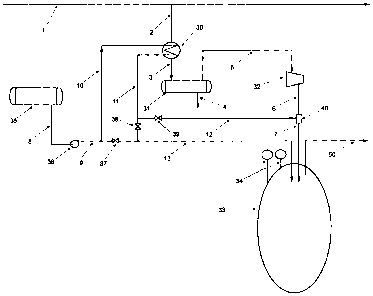Une partie des informations de ce site Web a été fournie par des sources externes. Le gouvernement du Canada n'assume aucune responsabilité concernant la précision, l'actualité ou la fiabilité des informations fournies par les sources externes. Les utilisateurs qui désirent employer cette information devraient consulter directement la source des informations. Le contenu fourni par les sources externes n'est pas assujetti aux exigences sur les langues officielles, la protection des renseignements personnels et l'accessibilité.
L'apparition de différences dans le texte et l'image des Revendications et de l'Abrégé dépend du moment auquel le document est publié. Les textes des Revendications et de l'Abrégé sont affichés :
| (12) Brevet: | (11) CA 2638663 |
|---|---|
| (54) Titre français: | PROCEDE PERMETTANT D'AUGMENTER LE DEBIT D'INJECTION MASSIQUE DE GAZ APPLIQUE AUX CAVITES DE STOCKAGE DE GAZ AU MOYEN DE GAZ NATUREL LIQUEFIE |
| (54) Titre anglais: | METHOD TO INCREASE GAS MASS FLOW INJECTION RATES TO GAS STORAGE CAVERNS USING LNG |
| Statut: | Accordé et délivré |
| (51) Classification internationale des brevets (CIB): |
|
|---|---|
| (72) Inventeurs : |
|
| (73) Titulaires : |
|
| (71) Demandeurs : |
|
| (74) Agent: | NATHAN V. WOODRUFFWOODRUFF, NATHAN V. |
| (74) Co-agent: | |
| (45) Délivré: | 2015-01-13 |
| (22) Date de dépôt: | 2007-07-20 |
| (41) Mise à la disponibilité du public: | 2009-01-20 |
| Requête d'examen: | 2012-05-23 |
| Licence disponible: | S.O. |
| Cédé au domaine public: | S.O. |
| (25) Langue des documents déposés: | Anglais |
| Traité de coopération en matière de brevets (PCT): | Non |
|---|
| (30) Données de priorité de la demande: | S.O. |
|---|
Une méthode permettant d'augmenter les débits d'injection massique de gaz appliqués aux cavités de stockage de gaz comprend l'utilisation du gaz naturel liquéfié (GNL) pour refroidir le gaz naturel dans un flux de conduite d'écoulement de gaz d'un compresseur utilisé pour comprimer le gaz en vue du stockage dans une cavité de stockage de gaz.
A method to increase gas mass flow loading rates to a gas storage cavern includes using liquid natural gas (LNG) to cool natural gas in a natural gas flow line upstream of a compressor used to compress gas for storage in to a gas storage cavern.
Note : Les revendications sont présentées dans la langue officielle dans laquelle elles ont été soumises.
Note : Les descriptions sont présentées dans la langue officielle dans laquelle elles ont été soumises.

2024-08-01 : Dans le cadre de la transition vers les Brevets de nouvelle génération (BNG), la base de données sur les brevets canadiens (BDBC) contient désormais un Historique d'événement plus détaillé, qui reproduit le Journal des événements de notre nouvelle solution interne.
Veuillez noter que les événements débutant par « Inactive : » se réfèrent à des événements qui ne sont plus utilisés dans notre nouvelle solution interne.
Pour une meilleure compréhension de l'état de la demande ou brevet qui figure sur cette page, la rubrique Mise en garde , et les descriptions de Brevet , Historique d'événement , Taxes périodiques et Historique des paiements devraient être consultées.
| Description | Date |
|---|---|
| Inactive : COVID 19 - Délai prolongé | 2020-07-16 |
| Représentant commun nommé | 2019-10-30 |
| Représentant commun nommé | 2019-10-30 |
| Accordé par délivrance | 2015-01-13 |
| Inactive : Page couverture publiée | 2015-01-12 |
| Inactive : Taxe finale reçue | 2014-10-17 |
| Préoctroi | 2014-10-17 |
| Un avis d'acceptation est envoyé | 2014-09-11 |
| Lettre envoyée | 2014-09-11 |
| Un avis d'acceptation est envoyé | 2014-09-11 |
| Inactive : QS réussi | 2014-08-27 |
| Inactive : Approuvée aux fins d'acceptation (AFA) | 2014-08-27 |
| Modification reçue - modification volontaire | 2014-05-26 |
| Lettre envoyée | 2013-12-12 |
| Lettre envoyée | 2013-12-12 |
| Inactive : Dem. de l'examinateur par.30(2) Règles | 2013-11-26 |
| Inactive : Rapport - Aucun CQ | 2013-11-18 |
| Modification reçue - modification volontaire | 2013-10-08 |
| Inactive : Dem. de l'examinateur par.30(2) Règles | 2013-04-10 |
| Lettre envoyée | 2012-05-30 |
| Exigences pour une requête d'examen - jugée conforme | 2012-05-23 |
| Toutes les exigences pour l'examen - jugée conforme | 2012-05-23 |
| Requête d'examen reçue | 2012-05-23 |
| Inactive : Lettre officielle | 2011-05-16 |
| Inactive : Lettre officielle | 2011-05-16 |
| Inactive : Page couverture publiée | 2009-01-21 |
| Inactive : CIB attribuée | 2009-01-20 |
| Demande publiée (accessible au public) | 2009-01-20 |
| Inactive : CIB en 1re position | 2009-01-20 |
| Inactive : CIB attribuée | 2009-01-20 |
| Inactive : CIB attribuée | 2009-01-20 |
| Inactive : CIB attribuée | 2009-01-12 |
| Inactive : CIB enlevée | 2009-01-12 |
| Inactive : CIB attribuée | 2009-01-12 |
| Inactive : Certificat de dépôt - Sans RE (Anglais) | 2008-10-02 |
| Exigences de dépôt - jugé conforme | 2008-10-02 |
| Demande reçue - nationale ordinaire | 2008-10-02 |
Il n'y a pas d'historique d'abandonnement
Le dernier paiement a été reçu le 2014-06-24
Avis : Si le paiement en totalité n'a pas été reçu au plus tard à la date indiquée, une taxe supplémentaire peut être imposée, soit une des taxes suivantes :
Veuillez vous référer à la page web des taxes sur les brevets de l'OPIC pour voir tous les montants actuels des taxes.
Les titulaires actuels et antérieures au dossier sont affichés en ordre alphabétique.
| Titulaires actuels au dossier |
|---|
| 1304342 ALBERTA LTD. |
| 1304338 ALBERTA LTD. |
| Titulaires antérieures au dossier |
|---|
| JOSE LOURENCO |
| MACKENZIE MILLAR |